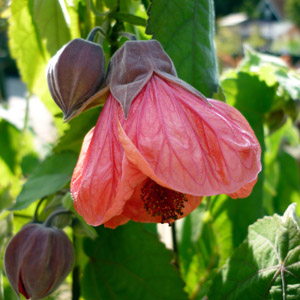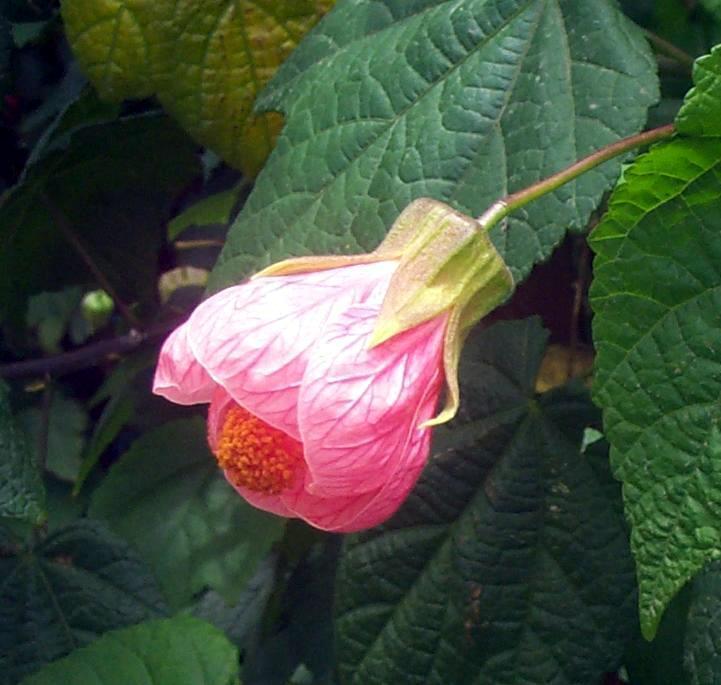These deciduous, tender shrubs and trees are natives of Brazil, tropical Asia and India and are commonly known as Flowering Maples. They have handsome foliage and gorgeous, bell- or saucer-shaped blossoms. A. 'Canary Bird' is a medium-sized shrub with large, apple green leaves and bright yellow, bell-shaped flowers, throughout the summer and into early autumn. A. 'Cannington Peter' is a medium-sized shrub that produces very dark red blossoms during the summer into early fall. This shrub has yellow-variegated foliage. A megapotamicum is a small- to medium-sized shrub bearing a profusion of lantern-shaped flowers from summer into the fall. These pendulous blossoms are bright yellow with a contrasting red calyx and purple anthers. It is best to grow this plant against a warm wall to provide heat and support. A. suntense var. 'Jermyns' is a large shrub bearing lavender to dark mauve, saucer-shaped flowers. A. suntense var. 'Violetta' is a large shrub with dark violet-blue to indigo, saucer-shaped flowers. A. vitifolium var. 'Tennant's White' is a large shrub that bears an abundance of very large, snow white flowers. A. Theophrastii, the Chinese Hemp or Indian Mallow, is a small bush that produces valuable fiber between the bark and wood of the stems. Several Abutilons produce this, but the Chinese Hemp is the most useful.
Pot Cultivation
Flowering Maples can be grown in the tropical and subtropical regions of both hemispheres. These plants are mainly suitable for growing along warm, sheltered walls, cool greenhouses or sunrooms, although A. suntense, A. vitifolium and their varieties are suitable for growing as freestanding plants in sheltered, sunny locations. Flowering Maples do well in average, dry soil though rich soil consisting of two-thirds loam, one-third leaf mold and decayed manure is the best. When they are grown indoors, repotting should be done in the spring, as soon as new growth begins, at which time they are transplanted to slightly larger pots. Keep them in a warm and humid atmosphere for a few weeks and sprits them with water often. When they've formed a sufficient root system, they will flourish in full sun and good air circulation. Give them biweekly applications of liquid fertilizer. If they aren't receiving enough nutrients, the lower leaves will die. The soil should be kept drier during the winter, but not so much that the stems wither. Plants that are growing in pots or tubs in the greenhouse should have the topsoil replaced, in the spring, with the soil mixture described above. When this plant is grown as a climbing plant, the side shoots on the main branches should be cut back in March to within two or three buds of the base of the previous summer's growth. Old, weak branches are cut out. During the summer, the new shoots are tied to wire supports as they grow. Plants in pots are pruned in March, the shoots of the previous year's growth being pruned in half and kept warm and moist in a 55- to 60-degree temperature.
Propagation
Cuttings can be taken at almost any time of the year. They should be taken in March to produce pot plants in the fall and winter or in August to grow into plants used for summer bedding outside the following year. Side shoots, about 3 inches long, are taken off with a piece of the branch attached and placed in a propagating case in a warm greenhouse. Roots should form in three or four weeks. When they've formed roots, they should be potted individually in 3-inch pots and later, into larger ones. They'll bloom in 6- or 7-inch containers. When they are grown from cuttings in August, they should be repotted into 3-inch pots in which they'll remain until February, when they're transplanted to 5-inch pots. They should gradually be hardened off and planted outside when the weather is warm and settled. Flowering Maples can be grown from seeds sown in pots of finely sifted soil, in the spring, in a temperature of 55 degrees. The baby plants are potted and treated in the same way as cuttings, but they won't flower until the following year.
 |
 |
| A. Ashford Red |
A. Louise Marignac |
Varieties
- A. Ashford Red'
- A. Canary Bird'
- A. Cannington Carol
- A. Cannington Peter
- A. Kentish Belle'
- A. Louise Marignac
- A. megapotamicum & var. Variegatum
- A. milleri & var.Variegatum
- A. 'Nabob
- A. 'Patrick Synge
- A. 'Souvenir de Bonn
- A. suntense & var. Jermyns, Violetta, White Charm
- A. vitifolium & var. Tennant's White, Veronica Tennant
- A. Theophrastii.
- A. xhybridum.
|